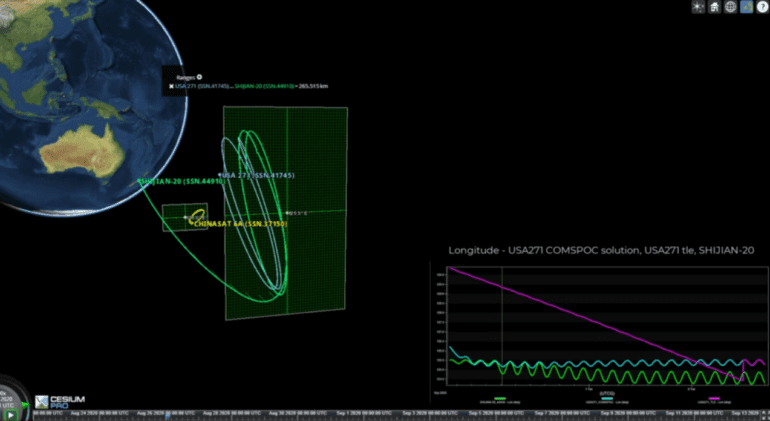TL;DR:
- Space Force seeks “actionable space domain awareness” and aims to prevent “operational surprise.”
- AI is crucial in analyzing data for identifying abnormal satellite behavior.
- Large language models like ChatGPT can extract insights from unstructured data.
- The focus has shifted to early detection of adversary actions in space.
- Challenges include overcoming cognitive biases and building trust in AI.
- Initiatives like MIT’s prize challenge aim to accelerate AI development.
- Access to commercially available data is a key requirement for training AI models.
Main AI News:
The Space Force, under the visionary leadership of Gen. Chance Saltzman, is on a mission to achieve “actionable space domain awareness” and eliminate the specter of “operational surprise.” In the world of high-stakes space operations, artificial intelligence emerges as the harbinger of transformation. AI algorithms, as per Lt. Col. Ashton Harvey, Chief Technology Officer at the National Reconnaissance Office, possess the remarkable ability to analyze vast streams of data in real-time, swiftly distinguishing between routine and anomalous events.
This capability is crucial in the quest to secure our interests in space, especially when dealing with adversarial actions. Thomas Roberts, a graduate research fellow at MIT, concurs. He emphasizes the wealth of historical data that can be harnessed to train AI models, making it possible to discern unusual behaviors exhibited by specific satellites, including those operated by entities such as the Chinese military.
Roberts himself has pioneered a groundbreaking software model, showcased at the AMOS Conference, designed to identify deviations in the behavior of satellites in geosynchronous Earth orbit. Such innovations align seamlessly with the Space Force’s strategic blueprint, particularly Gen. Saltzman’s “Competitive Endurance” concept, which revolves around three core tenets. Avoiding operational surprise ranks prominently among these, ensuring that our military commanders are never caught off guard by adversary actions.
The importance of “actionable space domain awareness” is articulated in a recent white paper. It elucidates how this concept amalgamates various elements such as intelligence, surveillance, reconnaissance, targeting, cooperative reporting, environmental monitoring, and decision support tools. The overarching goal is to provide timely and relevant indications and warnings, fortifying our ability to avert operational surprises during crises and, if necessary, take preemptive defensive measures. In the event of combat operations, this awareness becomes indispensable in disrupting adversarial space dependencies that threaten our Joint Force.
The potential of AI extends beyond historical data analysis. Large language models, like ChatGPT, offer an array of capabilities. They can process unstructured data sources, such as foreign-language news reports or video transcripts from social media platforms, to uncover hidden indicators that demand closer scrutiny. As articulated by Maj. Sean Allen, head of the Space Force’s Space Domain Awareness Tools, Applications, and Process Lab, AI-driven event detection has gained momentum. Col. Raj Agrawal’s directive to prioritize the detection of the initiation of a “kill chain” has spurred software engineers, machine learning specialists, and data scientists to actively engage in this endeavor.
However, the integration of AI into the military’s operational fabric is not without challenges. Cognitive biases and preconceived notions often lead humans to dismiss AI-generated insights, even when they deviate from conventional wisdom. Furthermore, overreacting to occasional AI errors can undermine trust in the technology. As Pat Biltgen, an AI expert at Booz Allen, rightly observes, trust in AI develops over time and requires a broader perspective beyond isolated instances of inaccuracy.
The novelty of using AI for space domain awareness contributes to the prevailing skepticism. The transition to AI-based models for satellite behavior analysis is uncharted territory, especially concerning questions of national security. In a bid to accelerate development in this domain, MIT is offering a prize challenge for innovators, focusing on identifying “patterns of life” for satellites. The Air Force-MIT AI Accelerator is providing funding for this initiative, demonstrating a commitment to fostering advancements in AI for space operations.
Another challenge lies in accessing commercially available data in suitable formats for training AI models. This is a fundamental requirement for AI development, and yet, it often remains unmet. The Space Force recognizes the importance of this aspect and acknowledges the need for readily available expert-labeled datasets to propel AI innovation.
Conclusion:
As the Space Force endeavors to secure the future of space operations, artificial intelligence emerges as a pivotal ally in achieving “actionable space domain awareness” and eradicating operational surprises. While challenges persist, the promise of AI-driven solutions shines bright, ushering in a new era of operational preparedness and strategic advantage in space.

